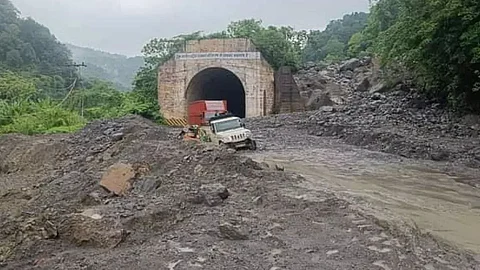
- Home
- Live Blog
- Breaking News
- Top Headlines
- Cities
- NE News
- Sentinel Media
- Sports
- Education
- Jobs

SHILLONG: Reports emerged on Friday that the recently cleared Sonapur tunnel in Meghalaya has once again become non-functional due to a landslide in the area. The tunnel, which connects Silchar to Guwahati and serves as a crucial link for several neighboring states such as Mizoram, Manipur, and Tripura, has been blocked as a result of the landslide. The continuous heavy rainfall in the region over the past few days is believed to have triggered the landslide. This unfortunate event has restricted vehicular movement, leaving many people stranded.
The Sonapur tunnel, located along National Highway 6, had been previously blocked for several days due to landslides caused by incessant rainfall. The landslides had left numerous vehicles stranded on the highway. However, after concerted efforts by the National Highway Authority of India (NHAI) and the Meghalaya administration, the tunnel was completely cleared for commuters on June 20. Traffic movement through the tunnel had been successfully resumed on Tuesday.
The recent landslide has once again disrupted the operation of the Sonapur tunnel, resulting in the blockage of the vital transportation link. This situation has severed communication with several northeastern states, including Assam, Mizoram, and Manipur. Hundreds of vehicles remain stuck and unable to move forward due to the landslide.
The region has experienced heavy rainfall, which is likely to have destabilized the terrain and contributed to the occurrence of landslides. Such natural disasters pose significant challenges for infrastructure and transportation systems, often resulting in disruptions and inconveniences for the affected communities.
Efforts to restore normalcy and clear the blocked tunnel are expected to commence promptly. The NHAI and local authorities will likely mobilize resources and equipment to remove the debris and ensure the safety of the affected area. Until the tunnel is cleared and deemed safe for travel, the movement of vehicles will continue to be restricted, causing further inconvenience to commuters.
Authorities will also need to assess the stability of the surrounding area and implement appropriate measures to mitigate the risk of future landslides. This may involve reinforcing the slopes, improving drainage systems, or implementing early warning systems to monitor geological conditions and provide timely alerts.
The safety of the stranded individuals should be a priority, and necessary arrangements must be made to provide them with adequate support and assistance. Local authorities may consider alternative routes or transportation options to facilitate the movement of people and goods until the Sonapur tunnel becomes operational again.
The unfortunate recurrence of the landslide highlights the vulnerability of infrastructure in hilly regions prone to heavy rainfall and landslides. It underscores the need for long-term planning, engineering solutions, and ongoing maintenance to ensure the resilience of critical transportation links in such areas.
As the authorities work towards restoring the Sonapur tunnel and addressing the challenges posed by landslides, the affected communities will eagerly await the reopening of this vital lifeline that connects them to essential services, trade, and communication networks.
ALSO WATCH: